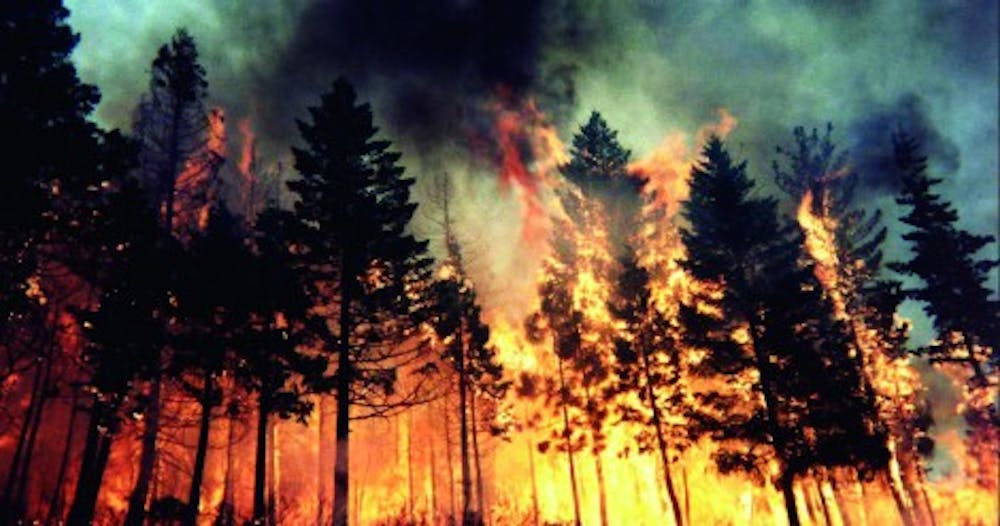BY JESS CARNEY
Wildfires raging across several Western states have destroyed over seven million acres of land. Coupled with droughts, high temperatures and windy conditions, they are proving to be relentless and difficult to contain.
Although thousands of men and women are working to fight the fires, countless homes are still in danger, and many are being asked to evacuate their homes. In addition to destroying property, the fires are threatening human lives.
The wildfire season has been particularly severe so far this year, with over 43,000 fires burning 8,122,876 acres. There are currently 80 active fires burning 1,871,291 acres across Arizona, California, Idaho, Montana, New Mexico, Oregon, Texas, Utah, Washington and Wyoming. Additionally, Alaska has around 5.1 million acres, or approximately five-sixths of the total acres, that have been burned during this year’s fire season.
This is the most devastating wildfire season in over 20 years, and the season will last until late November.
The United States is currently on a National Preparedness Level Five, the highest on the scale. According to the National Interagency Fire Center, a National Preparedness Level Five means that “geographic areas are experiencing major incidents which have the potential to exhaust all agency fire resources.”
The U.S. Forest Service has reported that it is spending over $100 million each week to fight these fires and that fighting fires will consume approximately half of the U.S. Forest Service’s budget, but resources are still limited. Supplies for those fighting the fires are running out with many crews surviving off of donations from the families that are fleeing their homes.
Although some areas such as parts of Washington are expecting rain this week, severe droughts in many other areas are making it difficult to obtain water for putting out the fires.
Approximately 30,000 firefighters and volunteers have been deployed across the United States, and more assistance is expected to arrive from the United States military, Canada, Australia and New Zealand.
This summer Canada has been coping with wildfires on its own land, including a forest fire that recently broke out in Glacier National park, Montana and spread to Canada’s Waterton Lakes National Park.
Last week three firefighters died in Washington while fighting a particularly fast-moving fire in the Methow River Valley near Twisp, Wash.
John Phipps, who is leading the U.S. Forest Service’s investigation of the incident reported that all three men, along with a fourth who escaped, were involved in a car accident before being caught by flames from the wildfire they were attempting to contain.
The men who lost their lives are Tom Zbyszewshi (20 years old), Andrew Zajac (26) and Richard Wheeler (31). All of them were members of a specially trained unit that was sent ahead of other units in order to assess the scope of a fire.
Although the investigation is still underway, it appears that the men were driving in a fire truck on Woods Canyon Road, a narrow and winding dirt path, when they veered off a steep incline. They were not killed in the crash itself, but damage to the vehicle prevented them from escaping before they were caught by the flames.
The only witness to the crash is survivor Daniel Lyon who managed to walk away from the truck but sustained burns on more than 60 percent of his body. He is currently in intensive care and unable to communicate effectively with investigators.
This incident brought the death toll from western wildfires this year up to 13. Relative to recent years this number of fatalities is not unusual, especially when considering the severity of this year’s fires. In 2014, there were 10 deaths as a result of forest fires, and in 2012 there were 15 deaths. The worst year in recent history was 2013, in which 34 fatalities were attributed to forest fires.
The cause of the increase in wildfire severity over the past few years is still not entirely clear, but many attribute the growth in fires to the effects of global climate change, including temperature increases and droughts.
The evidence does indicate a rise in forest fire intensity within the past few years.
There were only six other years since 1960 in which over eight million acres were affected by forest fires, and each of these years occurred in the twenty-first century.
In the case of Alaska, experts have noticed that a rise in the number of acres affected by forest fires has corresponded with several other environmental changes, including a 3.3-degree rise in Alaska’s annual average temperatures since 1959.
“The state is changing and changing rapidly,” Fran Ulmer, former lieutenant governor of Alaska and chairwoman of the U.S. Arctic Research Commission, said.





